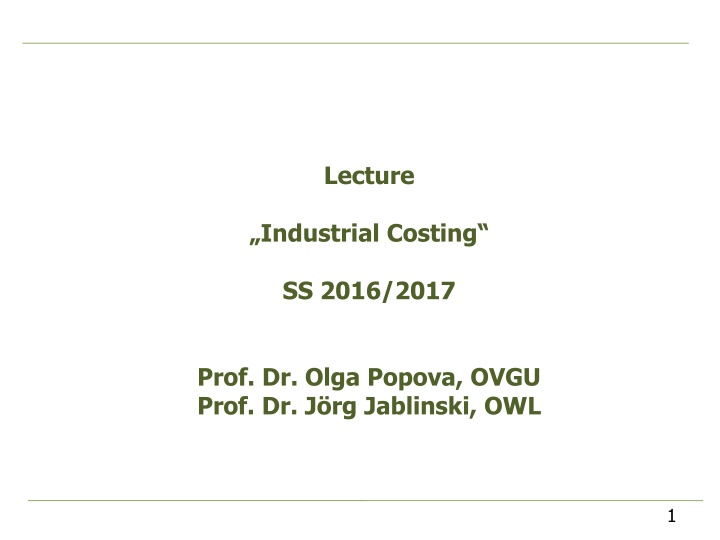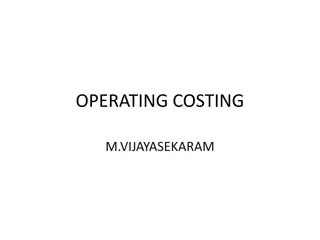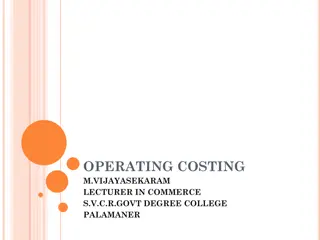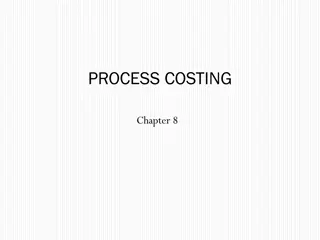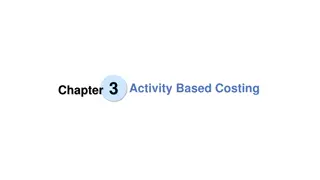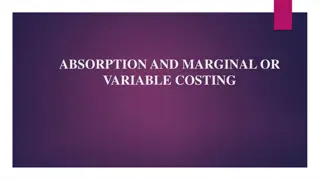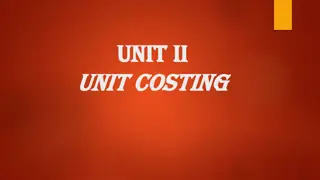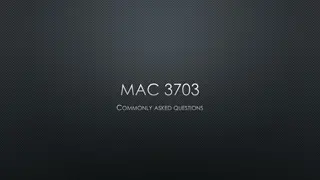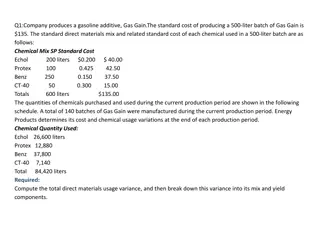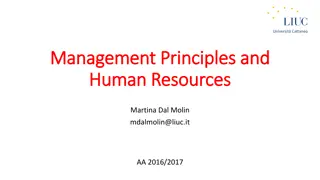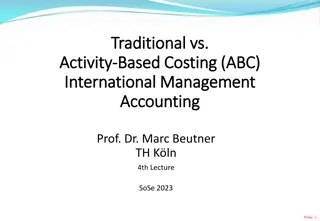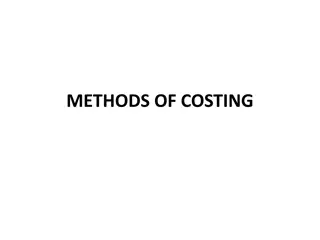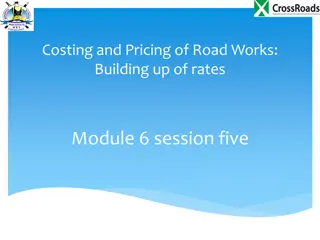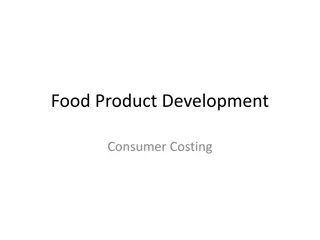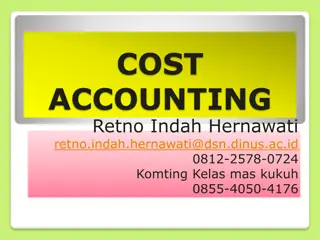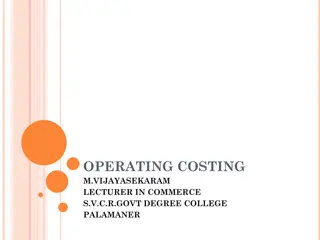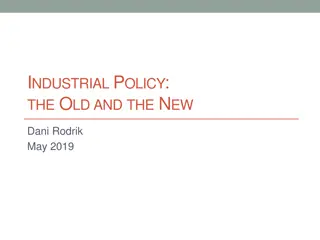Industrial Costing in Accountancy
Personnel costs, differentiation of costs, kinds of depreciation, depreciation methods, and example calculations. Delve into factors affecting depreciation amounts and residual values in linear depreciation. Gain insights into imputed linear depreciation and its application in determining yearly depreciation values.
Download Presentation

Please find below an Image/Link to download the presentation.
The content on the website is provided AS IS for your information and personal use only. It may not be sold, licensed, or shared on other websites without obtaining consent from the author.If you encounter any issues during the download, it is possible that the publisher has removed the file from their server.
You are allowed to download the files provided on this website for personal or commercial use, subject to the condition that they are used lawfully. All files are the property of their respective owners.
The content on the website is provided AS IS for your information and personal use only. It may not be sold, licensed, or shared on other websites without obtaining consent from the author.
E N D
Presentation Transcript
Lecture Industrial Costing SS 2016/2017 Prof. Dr. Olga Popova, OVGU Prof. Dr. J rg Jablinski, OWL 1
Chapter 3 Cost type accounting (Part 2) 2
Personnel costs Personnel costs Salaries Wages Additional personnel expenses Salaries for orders Statutory APE Direct labor costsfor orders Tariff APE Nonproductive salaries Nonproductive labor costs Operating APE Other APE 3
Differentiation of costs Costs Imputedcosts Operatingcosts Outlaycosts Additional costs -Imputed depreciation -Imputed risks -Imputed interest on borrowed capital -Imputed rent -Imputed employer's salary -Imputed equity capital interest 4
Kinds of depreciation Depreciation Imputeddepreciation Book depreciation Difference between book and imputed depreciation Kind of depreciation of fixed assets Imputed depreciation Book depreciation Parameter Base of depreciation Acqisition-and productioncosts Replacementvalue Estimated actual life cycle Freelyselectable, mostlylinear Durationof depreciation Tablesof depreciation Timedepreciation/ unit-of- productiondepreciation Type of depreciation 5
Depreciation methods Depreciationmethods Unit-of-productiondepreciation Timedepreciation Degressive Progressive Linear Declining-balance method Sum-of-the-year's digital method 6
Depreciation amounts and residual book value in linear depreciation Liquidationproceeds in linear depreciation Depreciationamounts(A) in linear depreciation (in /period) Residual book value (in ) (in years) (in years) 7
Example: Imputed linear depreciation A machine that was purchased for 95.000,- is expected to cost 110.000,- after the end of four years of useful life. Residual value (liquidation proceeds) will amount to 10.000,- . Imputed depreciation per year in linear depreciation can be calculated as follows: Imputed depreciation = ??????????? ????? ???????? ???? ????? 110.000, 10.000, = 25.000,- /year = ? 4 ????? 8
Example: Declining balance method A machine was purchased for 66.000,- . Residual value (liquidation proceeds) will amount to 12.000,- after 6 years. Imputed depreciation per year in % (p) can be calculated as follows: 6 12.000, 66.000, ) * 100 = 24,7327206 % p = (1 - Depreciation amounts and residual book values can be calculated with this percentage as follows: Depreciationamount Year Residualvalue 0 1 2 3 4 5 6 66.000,00 49.676,40 37.390,07 28.142,49 21.182,09 15.943,18 12.000,00 16.323,60 12.286,33 9.247,58 6.960,40 5.238,91 3.943,18 9
Example: Digital method A machine was purchased for 75.000,- . Residual value (liquidation proceeds) will amount to 15.000,- after 5 years. Degression amount per year in (p) can be calculated as follows: p = 75.000, 15.000, 1+2+3+4+5 = 4.000,- Depreciation amounts and residual book values can be calculated as follows: Year 0 1 2 3 4 5 Depreciationamount Residualvalue 75.000,- 55.000,- 39.000,- 27.000,- 19.000,- 15.000,- (5x4.000,- ) = 20.000,- (4x4.000,- ) = 16.000,- (3x4.000,- ) = 12.000,- (2x4.000,- ) = 8.000,- (1x4.000,- ) = 4.000,- 10
Example: Digital method The following table shows the percentage price development of a machine with eight years of useful life, which was purchased in 02 year for 265.500,- . The task is, to calculate the replacement value and depreciation for the sixth year. Year 0 1 2 3 4 5 6 Priceindex 100,0 103,5 106,2 108,0 111,5 115,4 120,0 120,0 106,2= 300.000,- Residual value in year 06 = 265.500,- * The next step is to calculate imputed depreciation for year 06: 300.000, 8 ????? Imputed depreciation = = 37.500, In year 06 this machine has a depreciation amount of 37.500,- . 11
Example: Imputed interest Fixed assets from the balance sheet; it consists of Depreciable fixed assets measured at average- and residual values Not depreciable fixed assets measured at acquisition- and production costs + current assets from the balance (measured at imputed average values) - non-operating fixed assets + not reported, operating fixed assets + not reported, operating current assets = Operating assets - non-interest-bearing liabilities (= interest-free borrowed capital) = Operating capital 12
Acquisition costs of the machine amounted to 180.000 EUR. The residual value (liquidation proceeds) at the end of useful life amounts to 60.000 EUR. The machine s useful life dures 6 years and imputed interest rate amounts to 10%. At first will be calculated average capital commitment and imputed interest (for all periods and useful life) due to Average method: Ca=180.000+60.000 2 Ii=180.000+60.000 2 Calculation due to residual value method: At first will be calculated annual imputed depreciation. Imputed depreciation = AV RVn n 6 years Development of imputed interest after using of this method can be presented in the following way: I1=180.000+160.000 2 I2=160.000+140.000 2 I3=140.000+120.000 2 I4=120.000+100.000 2 I5=100.000+80.000 2 I6=80.000+60.000 2 It can be seen, that in the residual value method the interest decreases over time proportionally to reducing of residual value (or residual book value). = 120.000, x0,1 = 12.000, =180.000 60.000 = 20.000, /year 0,1 = 17.000, 0,1 = 15.000, 0,1 = 13.000,- 0,1 = 11.000, 0,1 = 9.000, 0,1 = 7.000, 13
Evaluation of assets Assets Examples Evaluation Not depreciable fixed assets Investments, premises Acquisition value (AV) from the balance or present value Average amount committed Average method depreciable fixed assets Machines, buildings, factory and office equipment transport fleet, ?? 2or with residual value Using of this method leads considering linear depreciation to evenly load accounting periods. Average residual value of the period t= Capital commitment period=??? 1+??? 2 These positions are subjected in the course of period mostly strong fluctuations, therefore will be considered the average stock of period. ??+?? 2 of several Residual value method depreciable fixed assets Machines, buildings, factory and office equipment transport fleet, per Current assets Raw materials and supplies, goods, semi-finished finished products, cash assets, bank balance, debt claim and 14
Example: Calculation of imputed interests In the following example is presented the way of calculation of operating capital and imputed interest of the general partnership Schmidt. Below are listed the assets of the general partnership Schmidt. The rate of interest amounts to 10 %. Note: investments don't concern operation financial assets. Moreover the leasing of property to a farmer amounts to 50.000 EUR. Additionally is a vehicle for 10.000 EUR, which is used for private drives, included in the balance sheet. Liquid assets are used for operational purposes only to an extent of 75 %. Fixed assets Property Machines Transport fleet Investments Current assets Average inventory of raw materials and supplies Average inventory of finished products Average accounts receivable Average liquid assets Average bank balance Average cash balance Average advance payments received Average trade accounts payable 270.000,- 140.000,- 50.000,- 60.000,- 38.000,- 24.000,- 18.000,- 11.000,- 8.000,- 6.000,- 13.000,- 15
Example: Calculation of imputed interests Operating fixed assets Property Machines (140.000,- : 2) Transport fleet [(50.000,- -10.000,- ) : 2] 220.000,- + 70.000,- + 20.000,- = 310.000,- Current assets Average inventory of raw materials and supplies Average inventory of finished goods Average trade accounts receivable 38.000,- + 24.000,- + 18.000,- = 80.000,- Cash and cash equivalents Average bank balance (11.000,- x 0,75) Average cash balance (8.000,- x 0,75) 8.250,- + 6.000,- = 14.250,- = 404.250,- Average operating assets Non-interest-bearing liabilities Average advance payments received Average trade accounts payable - 6.000,- 13.000,- - Average operating capital = 385.250,- Imputed interest = operating capital x interest rate = 385.250,- * 0,1 = 38.525,- 16
Categories of imputed risks Type of risk Reference value Examples Loss in storage because of stock shrinkage, theft, obsolescence of stock, technical and economic progress Loss because of false investment, quicker wear than planned, machine breakage, disasters, accidents Defective goods because of material-, processing- or construction error, more costs because of rework Default on receivables, non- acceptance of ordered good, exchange rate fluctuations, goodwill reduction Loss from guarantee obligations, for example later improvement, free replacement delivery etc. Loss because of failed researching- and development works Liability claims from accidents and environment liability Inventory risk Average inventory value Acquisition- and replacement value Investments risk Production costs of produced goods Production risk Distribution risk Average accounts receivable Guarantee risk Production costs or turnover Development risk Costs for development Other risks Turnover, total costs Risk costs = risk rate * reference value of the period 17
Example: Calculation of imputed risks In the printing company with limited liability Sauer arose encountered risk because of defects. Due to prognostication, production costs for coming financial year will amount to 2,5 million . The risk costs can be calculated in the following way: Acounting period 01 02 03 04 05 Summe Encountered risk (production risk) 32.800,- 46.050,- 28.450,- 26.200,- 39.000,- 172.500,- Production costs 2,40 million 2,10 million 2,25 million 2,60 million 2,15 million 11,50 million 172.500, 11.500.000, = 0,015 x 100 = 1,5 % Risk rate= Risk costs for coming financial year = 0,015 x 2.500.000,- = 37.500,- 18
